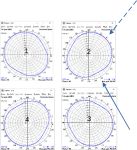Disclaimer: I'm just getting into RDF so a lot of this is new to me.
If I understand correctly, "good" doppler RDF designs use multiple PIN diodes to not only switch which antenna in the array is connected to the receiver at any given time, but to also switch the other "unused" elements to a high impedance state at center of the antenna in order to minimize their impact as parasitic elements that would create a directional radiation pattern. By switching them to high impedance, they are essentially two separate 1/4 wave elements that become relatively "invisible" to the antenna that's in use.
If that's the case, I'm thinking that it may be difficult or impossible to eliminate the parasitic effects in something like a Kerberos (now Kraken) SDR in which all four elements are continuously connected to four different (50-ish ohm) SDR receivers (no PIN diode switching)? And that therefore these coherent SDR RDF setups may be inherently more susceptible to multipath than a doppler set that uses switched antenna elements?
I did some rudimentary modeling in EZNEC (I'm a complete novice at this so I may have badly messed it up) that seems to show that when a single antenna is fed and the others have a high impedance at the center, the pattern of the fed antenna is very omindirectional, as we would want:

When the same antenna is fed but the other three antennas have a 50 ohm impedance at their centers, the pattern becomes distorted:

It looks like there is about 6 dB of directionality when all four antennas are connected to 50 ohm receivers at the same time. So if a multipath signal comes in at the right angle, it could be "overpowering" the "true" signal if it's within 6 dB. I'm not sure how likely that is.
Is my understanding correct, and if so, is there any workaround to address this when using the coherent SDR RDF rigs?
If I understand correctly, "good" doppler RDF designs use multiple PIN diodes to not only switch which antenna in the array is connected to the receiver at any given time, but to also switch the other "unused" elements to a high impedance state at center of the antenna in order to minimize their impact as parasitic elements that would create a directional radiation pattern. By switching them to high impedance, they are essentially two separate 1/4 wave elements that become relatively "invisible" to the antenna that's in use.
If that's the case, I'm thinking that it may be difficult or impossible to eliminate the parasitic effects in something like a Kerberos (now Kraken) SDR in which all four elements are continuously connected to four different (50-ish ohm) SDR receivers (no PIN diode switching)? And that therefore these coherent SDR RDF setups may be inherently more susceptible to multipath than a doppler set that uses switched antenna elements?
I did some rudimentary modeling in EZNEC (I'm a complete novice at this so I may have badly messed it up) that seems to show that when a single antenna is fed and the others have a high impedance at the center, the pattern of the fed antenna is very omindirectional, as we would want:

When the same antenna is fed but the other three antennas have a 50 ohm impedance at their centers, the pattern becomes distorted:

It looks like there is about 6 dB of directionality when all four antennas are connected to 50 ohm receivers at the same time. So if a multipath signal comes in at the right angle, it could be "overpowering" the "true" signal if it's within 6 dB. I'm not sure how likely that is.
Is my understanding correct, and if so, is there any workaround to address this when using the coherent SDR RDF rigs?


